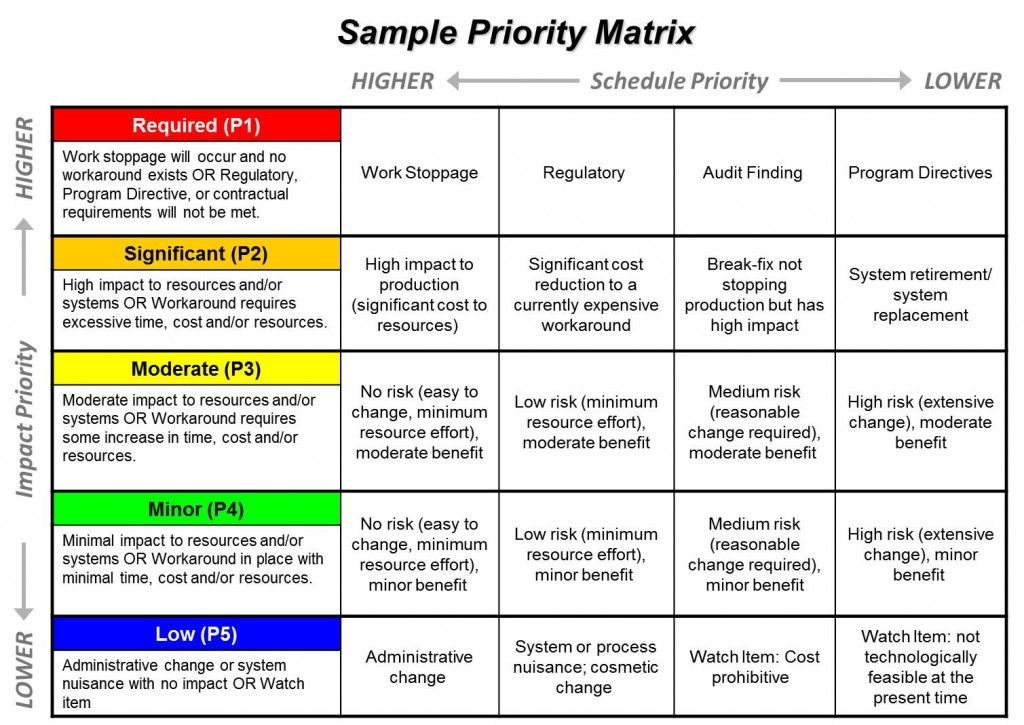In a recent LinkedIn discussion, questions were asked about the short-comings of prioritization matrices. I would like to highlight the strengths and weaknesses of using such a tool for portfolio management. Firstly, a priority matrix differs from a more traditional scoring approach in that it offers a limited number of priority selections. The most simplistic prioritization matrix has three choices, low, medium, and high. Of course, to be effective, every choice should have some predefined criteria. Otherwise, the matrix is of little value because decision makers can have wildly different views for what is of high importance versus low importance.
Strengths
Prioritization matrices have three primary strengths: simplicity, speed, and applicability to all types of work. Prioritization matrices are easy to understand and simple to use. Calculations are not required for determining the relative priority of a project. Basic criteria should be developed for each part of the matrix, but once complete, decision makers can apply the criteria to various types of work. Because of its simplicity, prioritization becomes a much faster exercise and allows decision makers to quickly distinguish important projects from less important projects. In addition, various kinds of work can be prioritized using a prioritization matrix. With a traditional scoring model, it is difficult to evaluate “keep the lights on” type of work, but with a prioritization matrix it is easier to compare priorities for project and non-project work.
Weaknesses
Prioritization matrices are unable to produce a rank ordered list of projects in a portfolio. At best, such a matrix can provide a categorical ranking of projects in the portfolio, but this won’t help prioritize projects within the same category. Prioritization matrices cannot do a good job of evaluating projects based on multiple criteria, and therefore cannot do a thorough job of distinguishing important projects from less important projects. When evaluating multiple large projects, a scoring system will provide a more accurate analysis over a prioritization matrix.
When Should a Prioritization Matrix Be Used?
Prioritization matrices are good for organizations new to the portfolio management process. Due to the simplicity, organizations can quickly get the benefit of prioritization without spending the time to do a thorough scoring of each project. Even in organizations where projects are scored and ranked, prioritization matrices can be used for “pre-screening” purposes to do a preliminary prioritization. This would be commonly used in a stage-gate process before a formal business case has been developed. A governance team could quickly determine a categorical priority for the project at an early gate review. Prioritization matrices can also be used to triage large volumes of project requests to focus the organization on the hottest projects. I have seen this approach used in an organization that received a high volume of small project requests. In this case, scoring would be an over-kill; the organization just needed to determine the most important work at that time.
- Prioritize Projects With A Scoring Model - October 11, 2018
- A Guide to Building a Project Prioritization Scoring Model - September 4, 2018
- Know The Difference Between Work Intake Versus Stage-Gate - April 1, 2018


I am trying to adopt the Sample priority matrix that you have posted here, but I’m missing the weights and scores they aren’t present in the model, just the definitions. For instance, I have 30 projects and I’m trying to determine base on requirements what projects are higher in schedule priority than the others. Do you have anything that can help me understand how the model you posted is used??? I would greatly appreciate it.
Dear Mr. Washington,
Is it possible that I use your Sample Priority Matrix in my thesis?
Sincerely,
This post on the Prioritization Matrix was incredibly insightful! I love how you broke down each component and provided clear examples. It’s definitely a tool I’ll be using for my projects moving forward. Thanks for sharing!